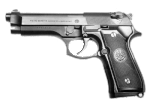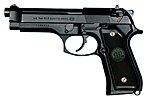Military Abolition Day
| Public Force of Costa Rica Fuerza Pública de Costa Rica | |
|---|---|
 | |
| Agency overview | |
| Formed | 1996 |
| Jurisdictional structure | |
| Operations jurisdiction | Costa Rica |
| General nature | |
| Specialist jurisdictions |
|
| Operational structure | |
| Parent agency | Ministry of Public Security |
| Child agency | |
| Notables | |
| Anniversary |
|
| Website | |
| seguridadpublica | |
The Public Force of Costa Rica (Spanish: Fuerza Pública de Costa Rica) is the national law enforcement agency of Costa Rica, whose duties include internal security and border control.[1]
History

On 1 December 1948, the President of Costa Rica, José Figueres Ferrer, abolished the Costa Rican military after his victory in the Costa Rican Civil War.[2][3] In a ceremony at the national capital of San José, Figueres symbolically broke a wall with a mallet, symbolizing an end to the military's existence.[4] In 1949, the abolition of the Costa Rican military was introduced in Article 12 of the Constitution of Costa Rica.[5] The budget previously dedicated to the military is now dedicated to security, education and culture. Costa Rica maintains Police Guard forces. The museum Museo Nacional de Costa Rica was placed in the Cuartel Bellavista as a symbol of commitment to culture. In 1986, President Oscar Arias Sánchez declared December 1 as the Día de la Abolición del Ejército (Military abolition day) with Law #8115. Unlike its neighbors, Costa Rica has not endured a civil war since 1948. Costa Rica maintains small forces capable of law enforcement, but has no permanent standing army.
Public Force of the Ministry of Public Security (1996)
In 1996, the Ministry of Public Security established the Fuerza Pública or Public Force, a gendarmerie which reorganised and eliminated the Civil Guard, Rural Assistance Guard, and Frontier Guards as separate entities. They are now under the Ministry and operate on a geographic command basis performing ground security, law enforcement, counter-narcotics, border patrol, and tourism security functions. The Costa Rica Coast Guard also operates directly under the Ministry but is not a part of the Public Force proper.[6]
Outside the Fuerza Pública, there is a small Special Forces Unit, the Unidad Especial de Intervencion (UEI) or Special Intervention Unit, an elite commando force which trains with special forces from around the world, but is not part of the main police forces. Instead, it is part of the Intelligence and Security Directorate (DIS) which reports directly to the Minister of the Presidency. About 70-member strong, it is organized along military lines, although officially it is a civilian police unit.
The motto of the Public Force is "God, Fatherland, and Honour." Commissioner of Police Juan José Andrade Morales serves as its current Commissioner General.
Ranks
- Comisario de Policía/ Director general de la Fuerza Pública
- Comisionado de Policía
- Comandante de Policía
- Capitán de Policía
- Intendente
- Sub Intendente
- Sargento de Policía
- Inspector
- Agente 2
- Agente 1
Equipment
Small arms
See also
References
- ^ "Costa Rica 1949 (rev. 2011)". Constitute. Retrieved 28 April 2015.
- ^ El Espíritu del 48. "Abolición del Ejército". Retrieved 2008-03-09.
{cite web}: CS1 maint: numeric names: authors list (link) (Spanish) - ^ Booth, John A. (2021-02-23). "Costa Rica: Demilitarization and Democratization". Oxford Research Encyclopedia of Politics. doi:10.1093/acrefore/9780190228637.013.1888. ISBN 9780190228637. Retrieved 2021-02-27.
- ^ "Historia militar de Costa Rica revive con los 100 años del Cuartel Bellavista". La Nación, Grupo Nación (in Spanish). Retrieved 2018-09-04.
- ^ "Air Advisors conduct first-ever BPC mission in Costa Rica". U.S. Air Force. Retrieved 2018-09-04.
- ^ "Servicio Nacional de Guardacostas". Ministerio de Seguridad Pública Costa Rica (in Spanish). Archived from the original on 4 August 2020. Retrieved 25 May 2020.
- ^ Central America Report. Vol. 24. Inforpress Centroamericana. 1997. p. 33.
- ^ Hogg, Ian (1989). Jane's Infantry Weapons 1989–90, 15th Edition. Jane's Information Group. pp. 826–836. ISBN 978-0-7106-0889-5.
- ^ "Latin American Light Weapons National Inventories". Federation of American Scientists. Archived from the original on October 22, 2012. Retrieved November 30, 2012. Citing Gander, Terry J.; Hogg, Ian V., eds. (1995). Jane's Infantry Weapons, 1995–1996 (21st ed.). Jane's Information Group. ISBN 9780710612410. OCLC 32569399.
- ^ Supica, Jim; Nahas, Richard (2007). Standard Catalog of Smith & Wesson. Iola, Wisconsin: F+W Media, Inc. pp. 141–143, 174, 210–211. ISBN 978-0-89689-293-4.[permanent dead link]
- ^ Bonn International Center for Conversion; Bundeswehr Verification Center. "MP UZI". SALW Guide: Global distribution and visual identification. Archived from the original on 31 August 2018. Retrieved 31 August 2018.
- ^ a b c d e Jones, Richard (2009). Jane's Infantry Weapons 2009-2010. Jane's Information Group. pp. 894–905. ISBN 978-0-7106-2869-5.
- ^ a b c d Gander, Jerry (2002). Jane's Infantry Weapons 2002–2003. Jane's Information Group. pp. 214, 899–906. ISBN 0-7106-2434-4.
- ^ a b "Customers / Weapon users". Colt Defense Weapon Systems. Archived from the original on 2 September 2011.
- ^ Gander, Terry J.; Hogg, Ian V. Jane's Infantry Weapons 1995/1996. Jane's Information Group; 21 edition (May 1995). ISBN 978-0-7106-1241-0.
- ^ Kemp, Ian (March 2007). "Lightweight Firepower" (PDF). Asianmilitaryreview.com - Asian Military Review. Archived from the original (PDF) on 7 July 2011. Retrieved 18 April 2010.
External links
- Fuerza Pública de Costa Rica.
- Ministerio de Seguridad Pública. Archived 2018-04-24 at the Wayback Machine
- El Espíritu del 48: Abolición del Ejército A brief history of the abolition of the military in Costa Rica.
- Latin American Light Weapons National Inventories




















